
Traditional Mexican Food: Everything you and Tom Hanks ever wanted to know but were too afraid to ask
Mexican food is fun, interesting, healthy, and enjoyable. But where did it originate from? What are the traditional recipes, how did the Spanish conquest in the 16th-century influence Mexican food? What other changes occurred to create 7 distinct food regions within Mexico? What’s Tex-Mex and what’s not Tex-Mex? And what authentic Mexican food is eaten at celebrations such as Christmas, Weddings, Independence Day, and Day of the Dead? We provide answers to these and many other questions. And there are 7 Classic Traditional Mexican Recipes to download and try for yourself.
This post is fun and interesting, and has a side plot of anecdotes from the nicest man in Hollywood – Tom Hanks. As well as questions about Mexican Food he was too afraid to ask!
HISTORY OF MEXICAN FOOD
While Tom Hanks and the Gen X’ers amongst us think that the 60’s shaped Mexican food the most, Mexican food history dates back 9,000 years. At that time, it’s had a variety of influences. Originally shaped by the Maya and the Aztecs, successive waves of other Mesoamerican groups brought new cooking methods. These included the Olmec, Teotihuacanos, Toltec, Zapotec and many others. Then in the 16th century European influences appeared after the Spanish arrived. Later still there have also been Asian and African influences on Mexican Food. And more recently an offshoot of Mexican food emerged, called Tex-Mex.
Mexican Food in the Pre-Hispanic Era
The indigenous people of Mexico in 7,000 BC hunted game and gathered plants for food. This included wild chili peppers. Their main source of food was agave hearts which they roasted.
It wasn’t until 1,200 BC that corn was cultivated from its wild variety. But it only became popular after it was softened for grinding. This paved the way for the creation of flatbreads and tortillas. As corn became more popular it grew in mythic proportions as well. Often with stories of the god Quetzalcoatl/Kukulkan passing it down as a gift.
Another staple food was beans which added extra protein to the diet. Even so, studies have still shown a protein deficiency in bones. Other foods available included turkey, grasshoppers, beetles, ant larvae, and iguanas. And on the coast, turtle eggs - although that practice is now prohibited. Vegetables included squash, jicama, a kind of sweet potato, and edible flowers. When the Spanish arrived in the 16th century, they found the indigenous peoples had advanced agricultural techniques. And an abundance of food.
Chocolate
In the Aztec empire, chocolate was treasured and cocoa beans were even used as currency. So treasured were the beans that they were regularly counterfeited by replacing the real nibs with ones made of clay.
Using the cocoa bean, the Aztecs would make a thick chocolate drink. But, instead of adding sugar, they added chili peppers, cornmeal and other spices. A similar drink is still found in Mexico today, called Atole. In fact, the word chocolate comes from the Aztec/Maya word chocolatl.
Aztec Recipes
Before the Spanish arriving the Aztecs didn’t use fat in their cooking. Many of their recipes were healthily prepared. Their recipes included steaming many foods such as Tamales, meat and fish, and Mixiotes. Mixiotes are the tough outer membranes of Agave leaves, to wrap the little bundles of food. Mixiote is a traditional Mexican food that is still found now. The Aztecs didn’t eat chicken but they may have made Mixiote with their domesticated turkeys.
As Forrest Gump said in 1994, "Life is like a box of chocolate".

But what Hanks didn't know was that chocolate was given to the world by the indigenous people of Mexico.
Maya Recipes
Like the Aztecs, the Maya were an agricultural society. Ninety percent of the Maya were involved in food production. Yet, like the Aztecs, the Maya also hunted deer, turkey, quail, ducks, monkeys, tapir and armadillo. However, meat was often a rare treat and not regularly eaten.
Honey was also produced by the Maya, by stingless honey bees. The honey was mixed with cacao, water, and chili peppers, to make a frothy dessert drink.
One of the Mayan food traditions that continue today in Mexico is their typical breakfast. Containing scrambled eggs, white cheese, beans and lots of hot tortillas. Now its often accompanied by a mug of locally grown and roasted coffee.

Chicken tamales. One of the most common authentic Mexican foods found today.
Tamales were a common Maya food. Formed from corn dough they contain a mix of meat and vegetables. One of the reasons they were so popular was because they can be easily transported. Using corn husks the cooked Tamales would be wrapped and then could be kept until later. When unwrapped they were often topped with salsa and eaten on the go. Modern-day Tamales in Mexico are quite authentic to the original recipes made by the Maya thousands of years ago. The complimentary 7 Classic Traditional Mexican Recipes, has a Vegan Tamale recipe from Chiapas.
Mexican Food in the Post-Hispanic Era
When the Spanish arrived in the 16th century they introduced many different foods and cooking techniques. These included influences from Europe and Asia too. Since the Spanish culture had been influenced for a long time from their various conquests and trade missions around the world. Initially the Spanish recreated their traditional recipes. But over time they also began to incorporate Mexican ingredients too.
Foods bought by the Spanish included olive oil, rice, onions, garlic, oregano, coriander, cinnamon, cloves, parsley, black pepper, almonds, apples, oranges, grapes, lettuce, carrots, cauliflower, and potatoes. As well they bought with them domesticated animals: pigs, sheep, cows, chickens, and goats. Cheese also was an important food. And the Spanish introduced frying as a cooking technique to Mexico.
However, Mexican food maintained its core related to corn, beans and chili peppers. Although there were many new ingredients, many of them weren’t available to the majority of the indigenous people. But, over time as rice and sugar cane grew well in certain parts of Mexico, the new ingredients began to become more available.
In the 19th century Mexican food changed again. This time it was due to the influx of migrants from France, Lebanon, Germany, China, and Italy. French food became popular with the upper classes. A variety of bread and sweetbreads such as bonillos and conchas were made. Bonillos (or Barras) are found throughout Mexico, are a type of savoury French bread. They are much shorter than a baguette.
Another food thought of as being traditional indigenous Mexican food is quesadillas. Yet, that’s not the case. Quesadillas were hybrid creations from both indigenous and Spanish influences. While the corn tortilla and chili are definitely from the indigenous culture, cheese, pork/beef and lettuce in the recipes are from the Spanish.
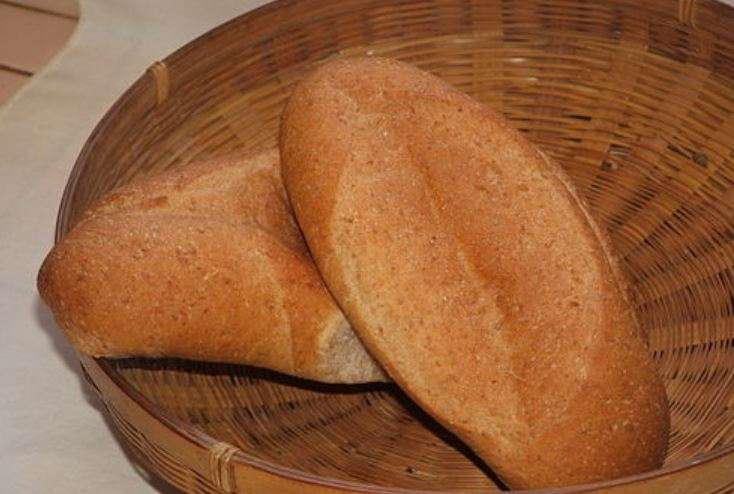
Inspired by the French, Bonillos are common to find in bakeries and supermarkets across Mexico
Other dishes that were indigenous-Spanish creations were pork loin in spicy sauce and Chili Rellenos. The famous mole sauce of Oaxaca is also a similar fused creation. Moles often contain, sesame seeds and anise, cinnamon, salt, black pepper, sugar, garlic, onion, cloves, coriander, raisins, lard, and pork. All introduced by the Spanish. But the defining ingredient is still the chocolate from indigenous Mexicans!
Tex-Mex Food
Since the 20th century, there has been an exchange between US and Mexican food. This has resulted in the creation of a subset of Mexican food – called Tex-Mex. While several popular recipes would be considered Mexican food by the masses, many are not traditional Mexican food. But are Tex-Mex. For example, tortillas made of flour!
Tex-Mex first surfaced in the 1940s and in the 1950’s Mexican restaurants in the southern US states increased. In part due to the increase in migrant workers from Mexico. It was here that northern Mexican peasant food met Texas farm and cowboy food. Chili, often regarded as Texas’s state dish, was unknown in Mexico at the time. Hardshell taco’s and enchiladas are both Tex-Mex creations. And the El Charro restaurant in Tucson, Arizona invented Chimichangas. While nachos first made their appearance at a concession at the Dallas State Fair of Texas in 1964. And fajita’s were introduced in Houston in the 1970s. It wasn’t until the 1970’s that Tex-Mex became popular. In large part due to English born, Diana Kennedy who elevated this offshoot of Mexican food to a trendy status.
On the Pacific coast, not unsurprisingly Mexican food is also dominated by seafood. Often made with European spices and chili. Marlin, swordfish, snapper, tuna, shrimp and octopus are common.
Mexicans love their beans. However, did you know that not all beans give you as much gas as others? Some, such as pinto beans result in far less gas. Also you can reduce the amount of gas they, or should we say you, give off after eating them! All you need to do is rinse them really well before using them.

Regional Mexican Food
Due to the many influences on Mexican food, regional differences in Mexican food evolved. Now seven main regions within Mexico have distinct food differences.
Northern Mexican Food
The northern areas in Mexico differ from those further south. In part because Europeans found the land suitable for raising cattle, goats and sheep. Thus, it led to meat dominating a lot of the dishes, especially beef. This ranch culture also led to outdoor grilling being the main cooking method. As well, cheese making on ranches has resulted in the largest variety of cheeses within Mexico. For example, queso fresco, fresh farmers cheese, or ranchero (like Monterey Jack). Cuajada is a creamy curd from fresh milk), while Requeson is similar to ricotta. Also, Menonita is a semi-soft cheese and there are many varieties of smoked cheeses (asadero).

Another important difference in the regional food of northern Mexico is the flour tortilla. Wheat grown here by the Spanish resulted in large tortillas. For example, those used in making burritos. Due to the desert climate, however, the northern region does not have a variety of foods that other regions in Mexico have.
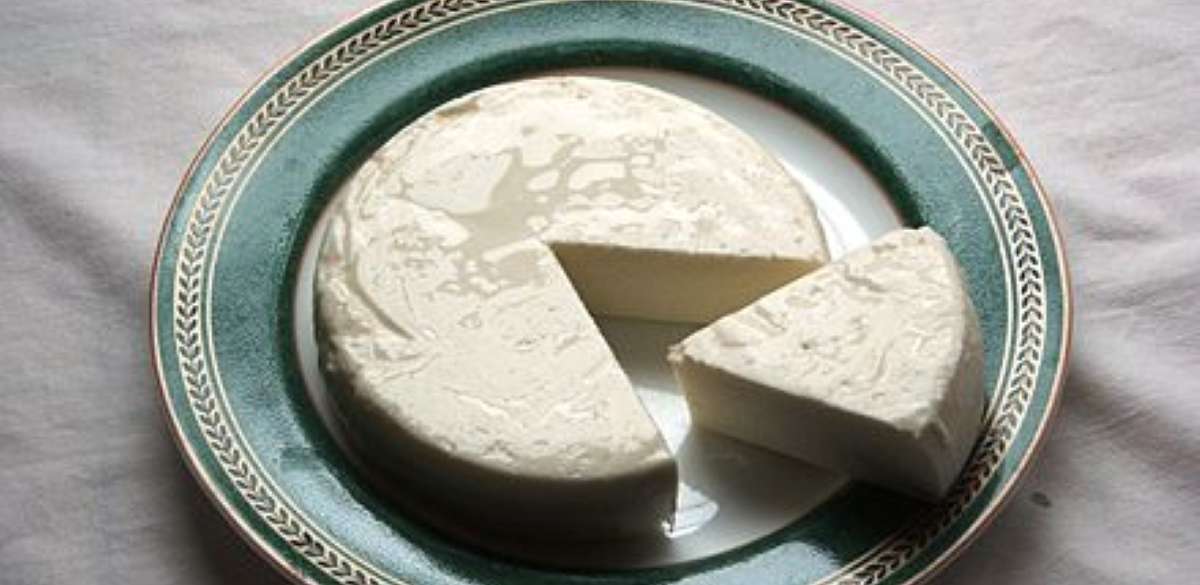
Queso Fresco
Common foods in this region are Cabrito, Skirt Steak, and Machaca, which all feature meat from the region. Cabrito, or roasted goat, can be prepared in many ways. The most famous is Cabrito Al Pastor. This is where the whole carcass is cooked on a spit over glowing embers and slowly roasted.
Skirt steak is a cut of beef that is long and flat and known for its flavour rather than its tenderness. A most common dish is Arrachera, where the marinated meat becomes tender before used in fajitas. An Arrachera recipe is included in our 7 Classic Traditional Mexican Recipes.
Machaca is dried meat, a common preservation technique in the desert climate. Usually made from spiced beef or pork, which is then rehydrated before. Machaca is often served with flour tortillas, such as in tacos or burritos. A popular breakfast dish is Machaca with eggs.
Western Mexico
West of Mexico City are the states of Michoacan, Jalisco, Colima and the Pacific coast. The food of Michoacan is still based on the culture of the Purepecha indigenous people. The region has many rivers and lakes introducing fish into many dishes. The Atole drink here is also made with a larger variety of flavours including blackberry. As well there are lots of types of tamales. Including those which come in different shapes such as Corundas which are triangular.
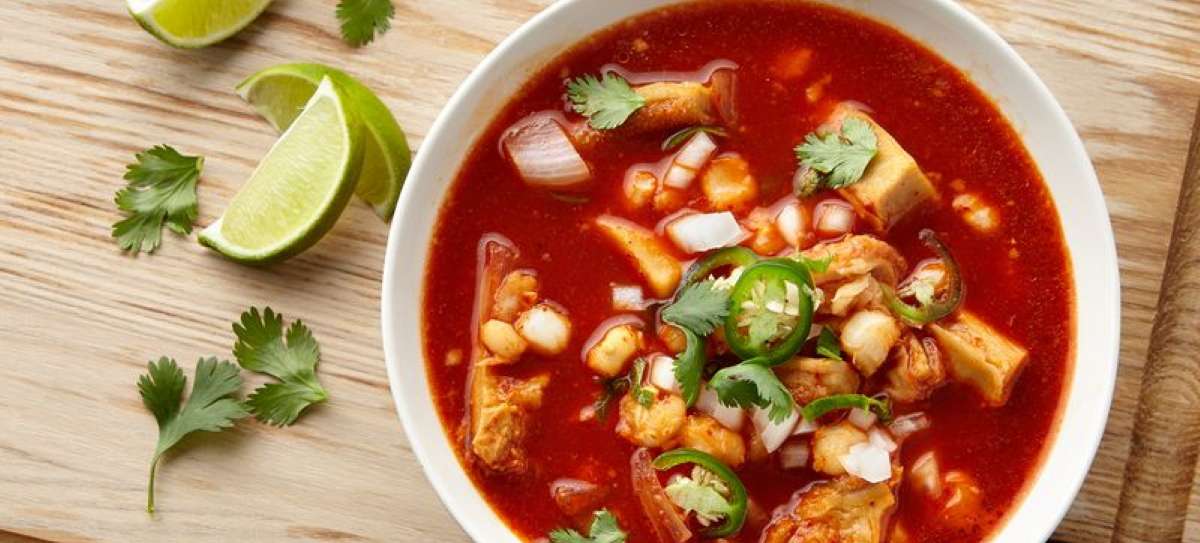
Menudo Soup - a hangover cure?
The Spanish influence on food in Michoacan includes rice, pork and spices. For example, the popular dish Morisquesta contains sausage, rice and beans. Carnitas (deep-fried pork) are also popular here. Sugar, also a Spanish introduction, led to a wide variety of sweets, fruit jellies and ice cream. Also famous throughout Mexico is Cotija cheese, named after the town in Michoacan.
Jalisco and Colima are noted for their pork dishes and Menudo, a soup made with cow’s stomach in broth with a red chili pepper base. There is a widely held belief that Menudo is a useful hangover cure. The gastronomic center of the area is Guadalajara, where agriculture and cattle farming have thrived. The best-known dish is Birria. Often made with beef it can also come with goat meat or mutton. The meat marinated in vinegar, dried chillies, herbs and spices is then cooked in a broth. Birria is a common meal at weddings, baptisms and holidays.
Another popular dish in Guadalajara is Torta Ahogada. In English meaning “drowned submarine sandwich”. The drowning occurs as the sandwich is partially submerged in a sauce made with Chili de Arbol. Pozole is another famous dish from outside of Guadalajara in the town of Tonala. Pozole is a traditional soup or stew made with dried maize kernels (hominy) and pork. It is often garnished with a variety of other ingredients including lettuce, cabbage, chilli’s, onion, garlic, radishes, avocado, salsa or lime. Pozole is often served on birthdays, Independence Day, and other holidays. But, always on New Year's eve. Pozole is the Western Mexico recipe in our downloadable 7 Classic Traditional Mexican Recipes.
On the Pacific coast, not unsurprisingly Mexican food is also dominated by seafood. Often made with European spices and chili. Marlin, swordfish, snapper, tuna, shrimp and octopus are common.

One of the reasons that Tom Hanks loves pre-Hispanic Mexican food is because it's so healthy. Perhaps it helped him lose 40 lbs so he could play the lead role in Castaway. Not only that but the no sugar pre-Hispanic indigenous food would be great for his diabetes.
Mexico City
Street food is the norm in Mexico City. Taco stands and lunch counters dominating most streets in the city. Since Mexico City contains migrants from all parts of the country every popular dish is here. Including Birria, Cabrito, Carnitas, Mole, Tortas, and many others. Huarache Toluqueno is a great example. It is a large Tostada made from blue corn! It's pounded rather than ground to make it courser in texture. Often, it is covered with beans, nopales (a type of cactus), cilantro and sometimes avocado and tomato.
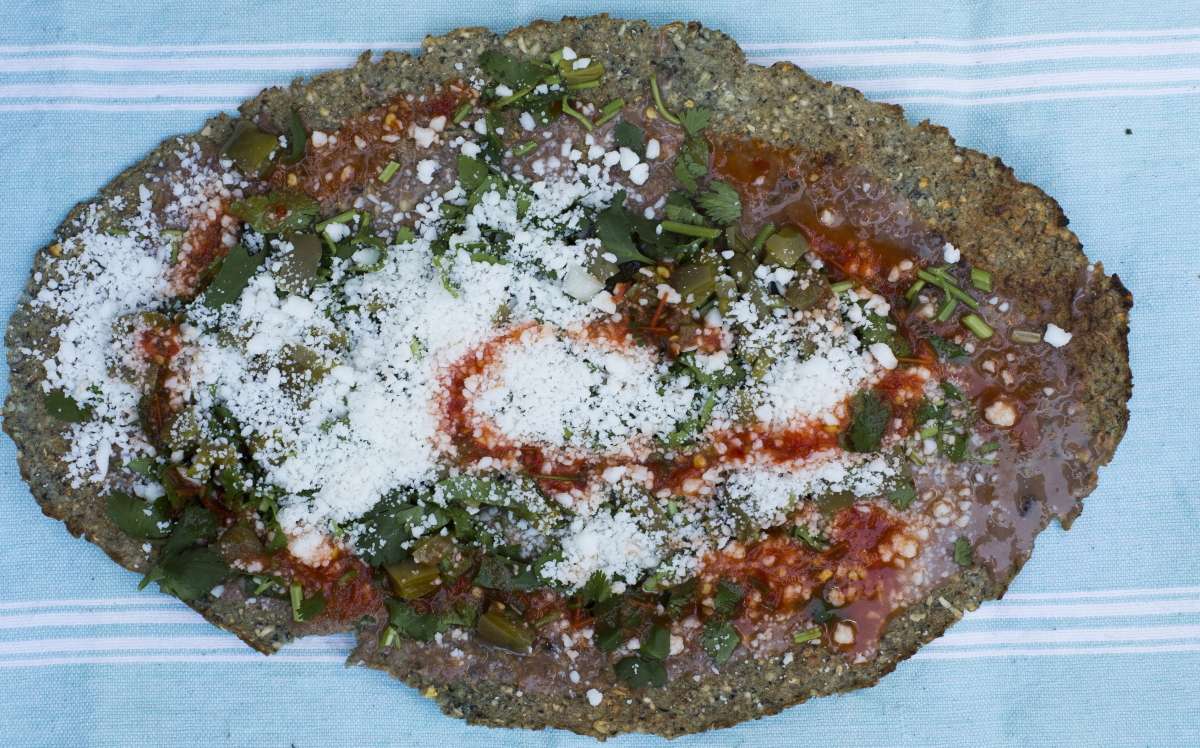
Huarache - made with blue corn!
Another interesting dish is Mapu Tofu and demonstrates the fusion of Mexican and Chinese food. In the late 1800’s Chinese migrants arrived to work on the railroads and developed Mexico City’s Chinatown. Along with that came new dishes fusing Mexican and Chinese foods.
The first taco sold on the streets of Mexico City were Tacos de Canasta. Prepared with a variety of cooked fillings they are also dressed with condiments. Then they are packed in cloth or a basket to make them easy to transport and handle. They are the taco of the labourer and office worker on a quick lunch break. Typical ingredients include beans, ground pork, and potato. They’re sold from taco stands, taco bicycles, or on tables outside storefronts and come with salsa, and chilies.
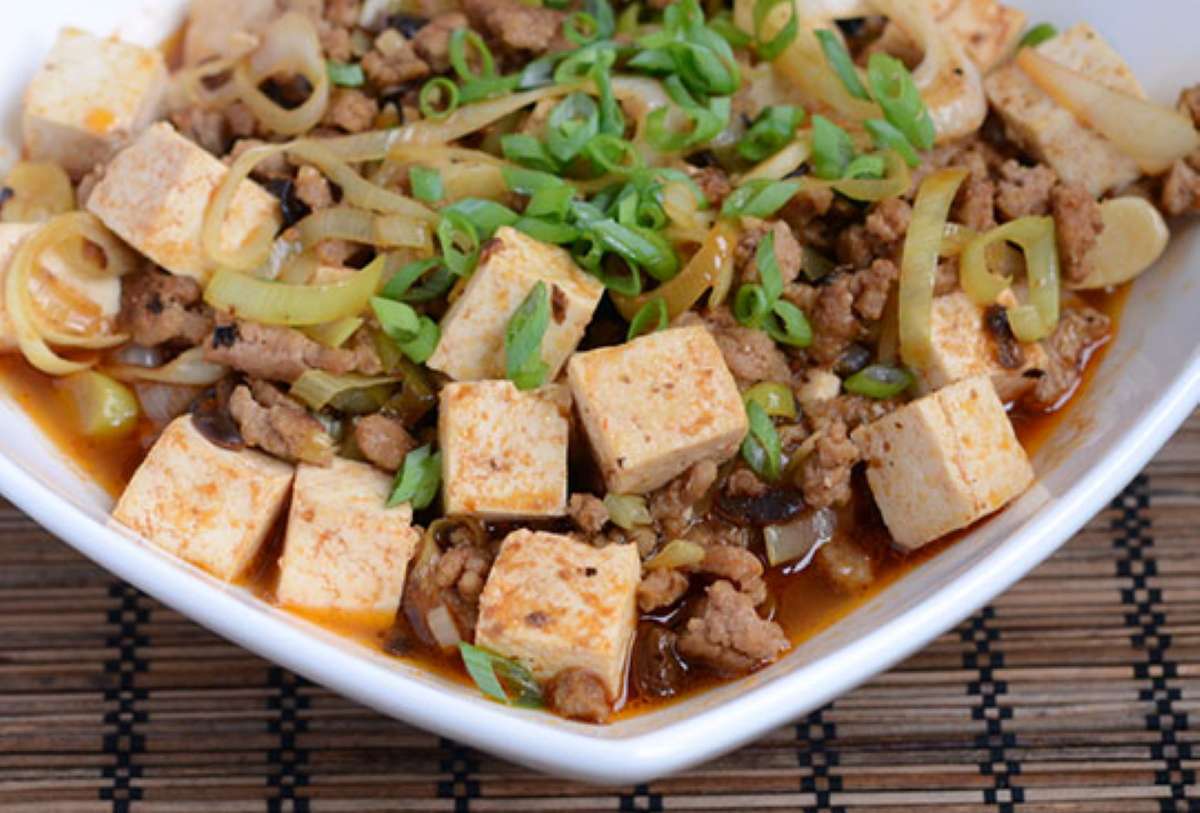
Mapu Tofu - one of the Asian influences on Mexican Food
One of the most famous dishes across Mexico is Tacos al Pastor. A Mexican version (with pork instead of lamb) of shawarma bought by Lebanese migrants to Mexico. It often includes a spicy adobo sauce and pineapple. This famous dish is Mexico City’s inclusion in our 7 Classic Traditional Mexican Recipes you can try making yourself. It's pretty easy and delicious.
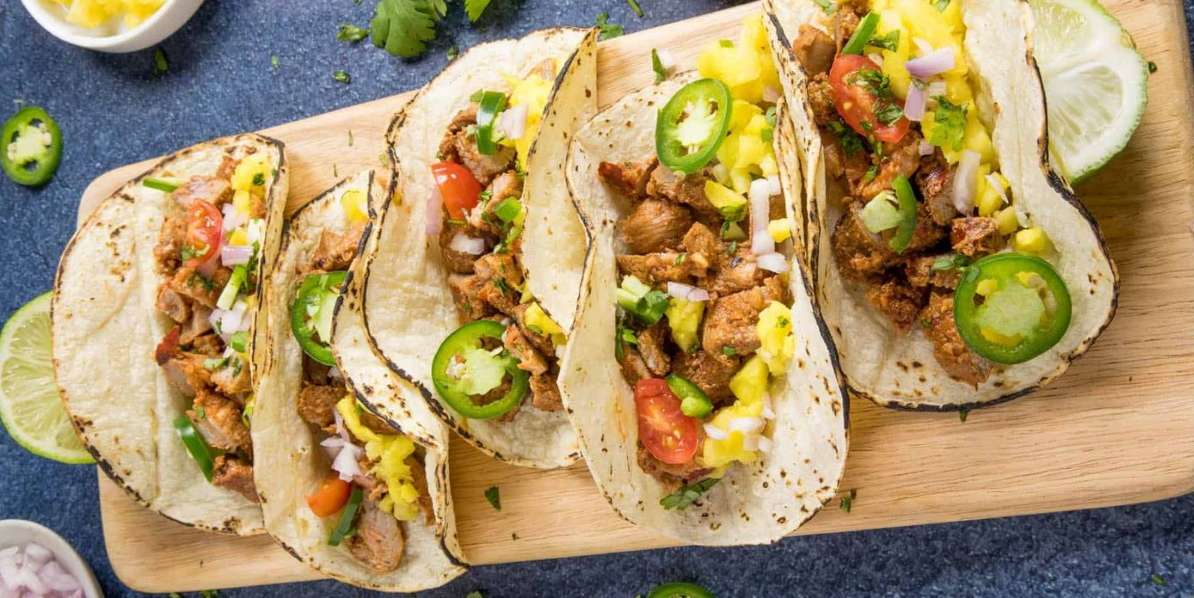
Tacos al Pastor - A must try classic
A typical traditional breakfast dish found in Mexico City and most places is Chilaquiles. Lightly fried tortilla is cut into quarters topped with red or green salsa. The dish is then topped with pulled chicken, scrambled or fried eggs, cheese, and cream. A healthy dollop of frijoles (refried beans) usually accompanies the dish too.
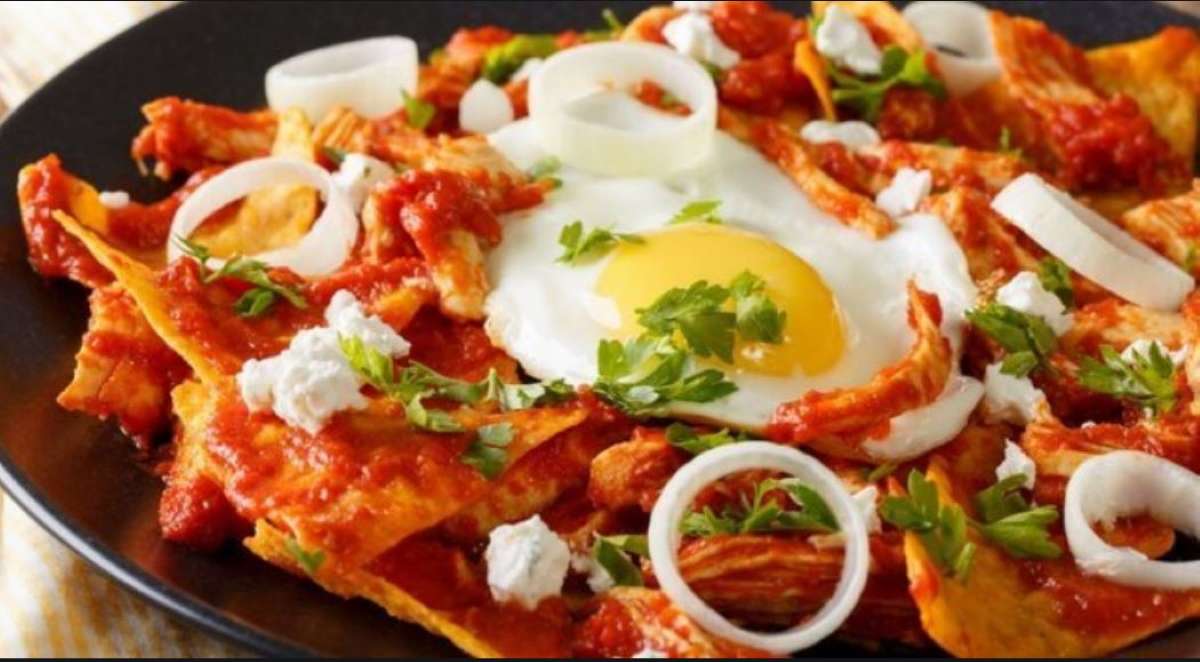
Mexican breakfast - Chilaquiles
Veracruz
Veracruz has an interesting mix of influences on its food. As expected, indigenous staples such as corn and vanilla are common ingredients. Also, there is a wide variety of tropical fruits from the Caribbean including papaya and mamey. These are in addition to citrus fruit and pineapple from the Spanish. As well as European herbs: parsley, thyme, marjoram, bay, and cilantro.
Many of these ingredients are in the popular dish Huachinango a la Veracruzana. A classic dish from Veracruz made with red snapper using olives and capers. First, the whole snapper is marinated in lime juice, salt, pepper, nutmeg, and garlic. Then baked in a sauce made from onions, garlic, tomato, jalapenos, olives and other herbs. You can try this recipe from our 7 Classic Traditional Mexican Recipes, it is truly a classic.
Other seafood is also common in most of Veracruz. Another famous specialty is a small crab stuffed in its shell with onion, garlic, tomato and herbs.
But, what is perhaps less expected is the African influence on food from Veracruz. Bought from the importation of slaves from the Caribbean adds a twist to local dishes. For example in Veracruz, rice is much more important here than corn.
Oaxaca
Oaxaca state has a wide variety of native foods. Including vegetables from the central valley, seafood from the coast, and tropical fruits bordering Veracruz. Much of the Mexican food here comes from the indigenous Mixtec and Zapotec people. Mole sauces are a major Mexican food inspiration that Oaxaca is famous for. Mole are traditional marinades or sauces and come in seven varieties: Negro (black), Amarillo (yellow), Coloradito (little red), Mancha Manteles, Chicilo (smoky), Rojo (red), and Verde (green). Chocolate is often found in Mole Negro.
Mole Negro with chicken, turkey or pork is a fabulous dish. However, making Mole Negro sauce requires a lot of ingredients. Including a variety of herbs, spices, nuts, vegetables, fruits, chiles, and of course chocolate! If you are an ambitious amateur chef try making Mole Negro in 7 Classic Traditional Mexican Recipes. It takes a while but it's worth it!

Chocolate Mole Negro con Pollo - get the recipe
Corn is also very popular in Oaxaca with tortillas eaten at every meal. Black beans are also a staple and used to flavour soups and sauces. Oaxaca is also famous for its Oaxaca cheese – an adaptation on mozzarella.
Chiapas
Like its neighbouring state of Oaxaca, corn and other indigenous foods remain a strong influence on Mexican food in Chiapas. But, used nowhere else in Mexico other than Chiapas is the chili Simojovel. It is a small very spicy red chili used in stews and hot sauces in the region.
In the highlands of the state, ranchers raise a variety of livestock. Beef, pork and chicken are common. As are a variety of cheeses made on the ranches and in small cooperatives. Meat and cheese dishes are often accompanied by squash, chayote (a type of gourd) and carrots.
Tamales dominate Mexican food in Chiapas and come in a variety of recipes. Including several vegan and vegetarian varieties. Chiapas’ contribution to 7 Classic Traditional Mexican Recipes is a recipe for vegan tamales.

Chayote
Chiapas is also the coffee mecca of Mexico. High altitude, good climate and rich soil results in some of the finest coffee in the world.
Yucatan Peninsula
Mexican food from the Yucatan is very distinctive from the rest of the country. Consisting of three states Yucatan, Campeche, and Quintana Roo it is the most well-regarded food area after Oaxaca. With influences from the Caribbean, central Mexico, Europe and Middle Eastern cultures. Corn is still a staple food here, and Pozole is a favourite here too. It consists of fermented corn dough along with other ingredients added to it for flavouring (e.g. cocoa). Pozole is an ancient soup (Western Mexico above).
Habaneros are also much more common here than in other parts of Mexico. But they are often served as a condiment, rather than as the main ingredient in a dish. One of the main spices in the region is Achiote. Achiote has a slight pepper smell along with a hint of nutmeg, is used to flavour many dishes, such as Cochinita Pibil. This famous Yucatan dish is included as one of the 7 Classic Traditional Mexican Recipes you can download to try at home. It’s delicious and an easy recipe to prepare.
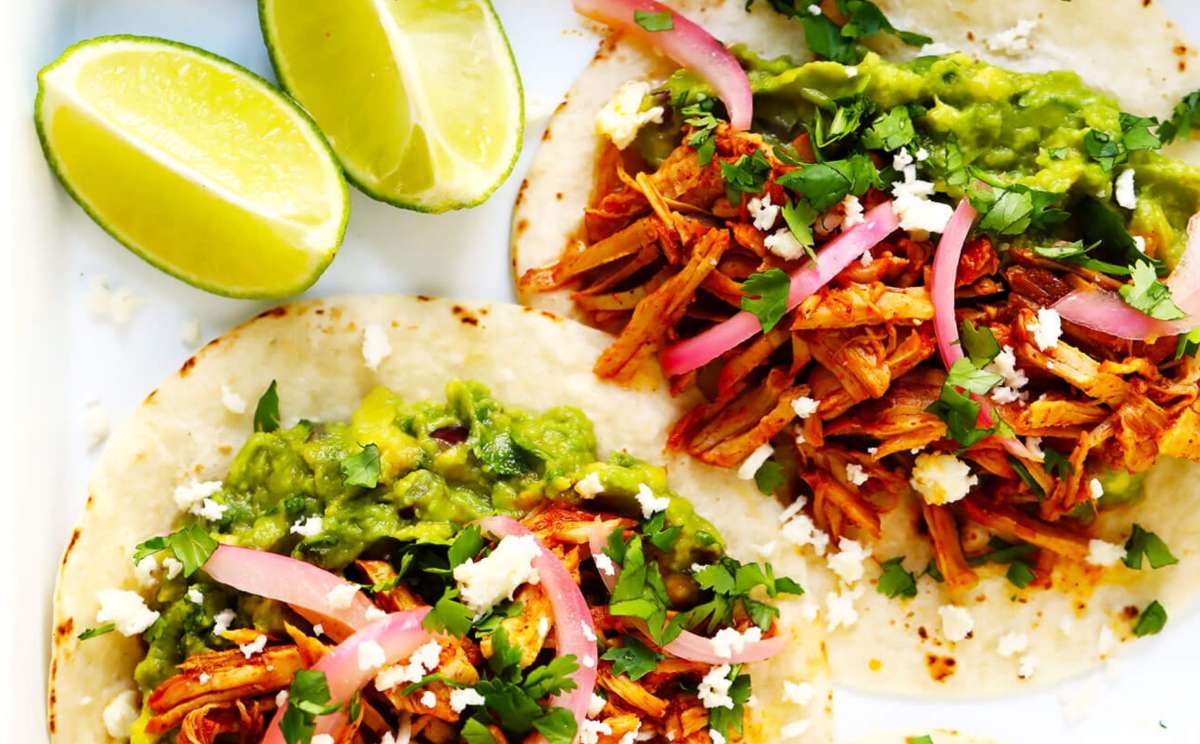
Cochinita Pibil - authentic and easy to make with our recipe
Also common in this region are tropical fruits including tamarind, plums, mamey, avocados and bitter oranges. Bitter oranges (a variety of the Seville orange used to make marmalade) are often used in salsa’s giving them a distinct flavour. The coastal areas including the Riviera Maya feature many seafood dishes served with spicy salsas. Lobster is popularly prepared with chili and tamarind sauces. During lobster season beachside restaurants in the Riviera Maya often offer lobster specials. Other common coastal dishes include coconut shrimp and conch fillet ceviche style marinated in lime juice. Ceviches are common along the Mayan Riviera coast.
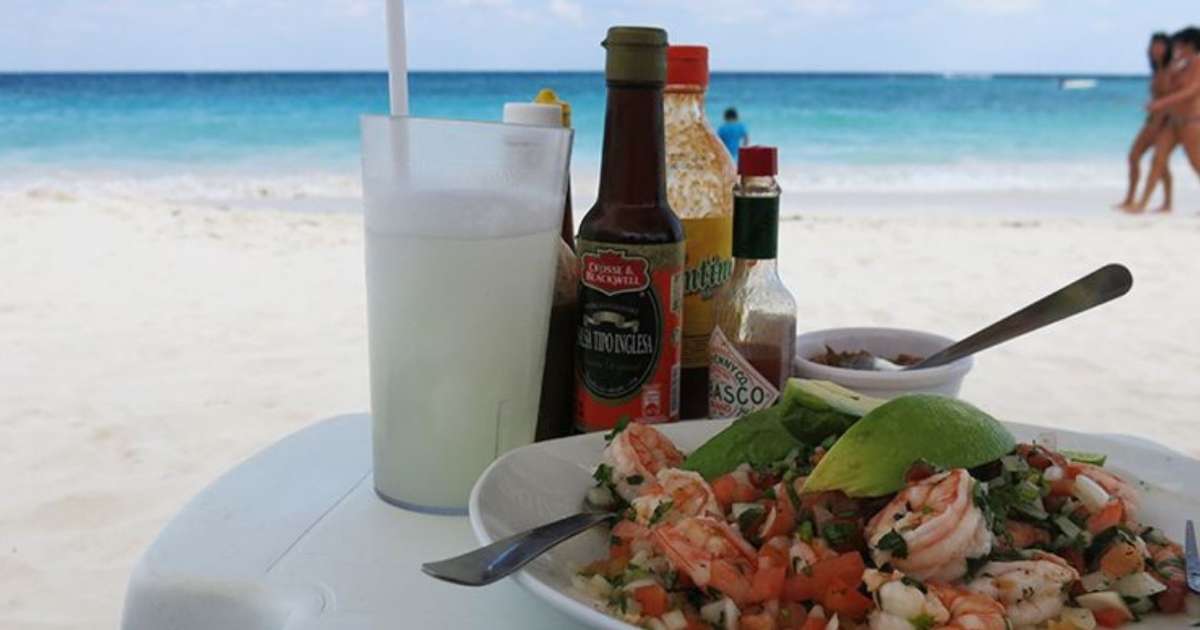
Shrimp ceviche on the beach in the Riviera Maya
Panucho is a Mexican food specialty made with a refried tortilla stuffed with refried black beans. Often topped with cabbage, pulled chicken or turkey, tomato, pickled red onion, avocado and pickled jalapeno pepper. Another common dish of the Yucatan is Queso Rellenos. A hollowed-out ball of Edam cheese, stuffed with ground pork and covered with tomato sauce and gravy.
Mexican Food Traditions
As with most cultures around the world, food is often a significant part of major celebrations. Whether those are holiday festivities, birthdays, weddings, or Independence Days. In Mexico, it isn’t any different with traditional favourites served at celebratory events.
Christmas Mexican Food Traditions
As in many places the Christmas tradition includes families gathering and celebrating over food. In Mexico, the celebration for Christmas is Las Posadas and begins on December 16th. This 9-day event features many traditional events and activities.
The traditional Christmas dinner starts late on Christmas Eve. After midnight mass church services. Often the meal begins with oxtail soup with beans and chilli’s, followed by roasted turkey. Other favourite foods include Bacalao, ham, mole and Ponche to drink. Ponche is a hot fruit punch.
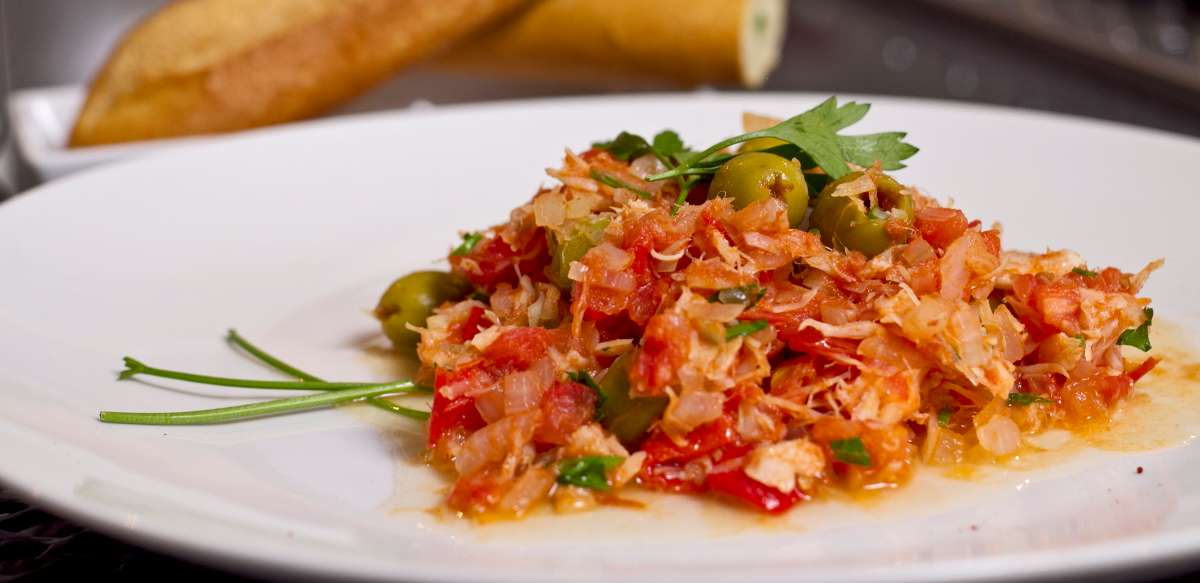
Mexican food at Christmas includes Bacalao (salted cod fish)
Tamales always appear at some point during Las Posadas and are a traditional favourite. But one of the most traditional dishes is Bacalao – dried salted cod. A European dish, often stewed in tomatoes, capers, olives and potatoes.
Rosca de Reyes is a sweet bread often served on the day of the kings, usually celebrated on January 6th. This sweetened pastry looks like a wreath decorated with candied figs, lemon, cherries, and mango. And it is usually served with syrup or ground sugar on top.
Bunuelos is another traditional favourite as well. They look like Tostados and are a crispy treat sprinkled with fine sugar or syrup. It goes well with Ponche or other hot beverages.
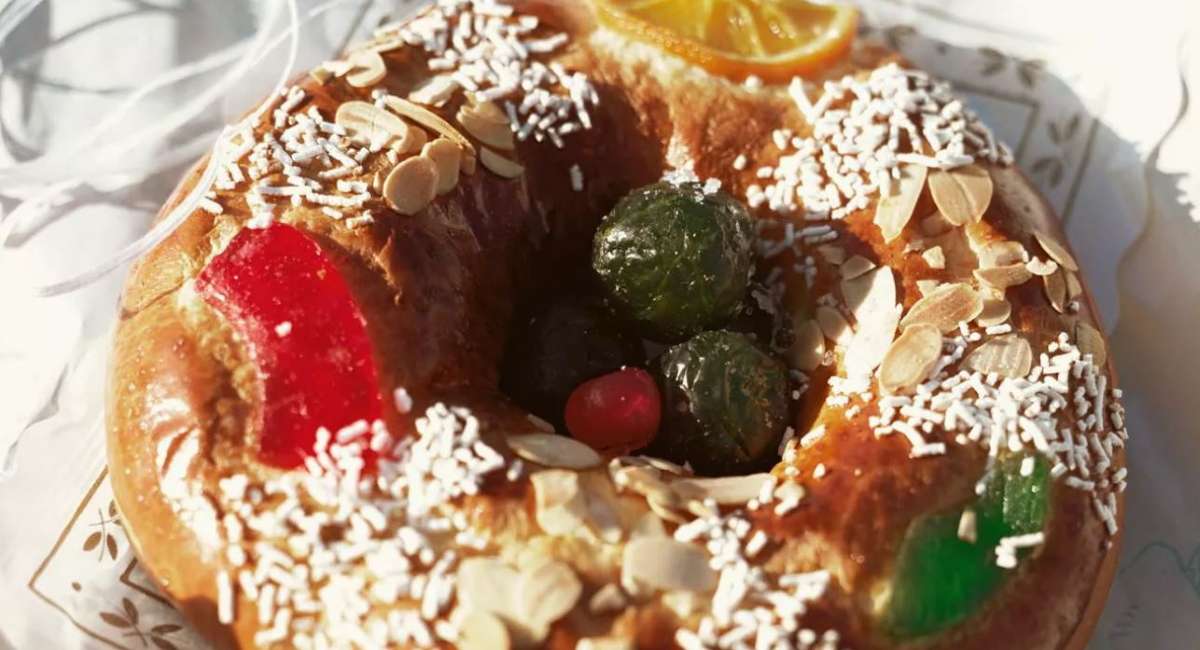
Roses de Reyes
New Years Eve
New Year’s Eve in Mexico, called Nochevieja, is a big deal. As in many places around the world family and friends gather on Dec 31st to celebrate good luck, fortune, and health. As with Christmas the Mexican food feast begins just before midnight on Dec 31st. At New Year, Pan Dulce – a cake with a lucky coin in the middle is common. Whoever gets the coin in their slice, is said to be the luckiest person for the year.
Then as the countdown begins, Mexicans eat 12 grapes, one a minute in the 12 minutes before midnight. The 12th one eaten as the clock strikes midnight. The grapes represent the 12 months of the year. Tradition says that if the first grape is sweet then the first month of the new year will be good. If you get a sour grape it means you’re in for a bad year.

Bunuelos dripping with syrup !
As with Christmas many of the traditional favourite foods include Bacalao, Bunuelos, Ponche, and Tamales. But, unlike Christmas, eating cooked lentils on New Year's Eve is said to bring good fortune.
Easter
While you’re unlikely to find many chocolate Easter bunnies in Mexico it doesn’t mean that Mexicans don’t celebrate Easter. Quite the opposite. Easter is much more important in Mexico than many other holidays. But Mexicans take a more traditional religious view of the celebration. It's so important that many Mexicans take several days off before and after Easter Sunday.
As with most celebrations, Mexican food plays a large part as well at Easter. Since tradition dictates that Roman Catholics eat no meat in the 40 days before Easter Sunday, Mexicans eat a lot of fish, shrimp and other seafood. Fish soup made with pieces of fish and lima beans is traditional. While shrimp is often eaten raw or in patties covered in a sauce made of spices and pumpkin seeds. Another typical Easter dish is Nopal – a flat-leafed cactus used in salads.
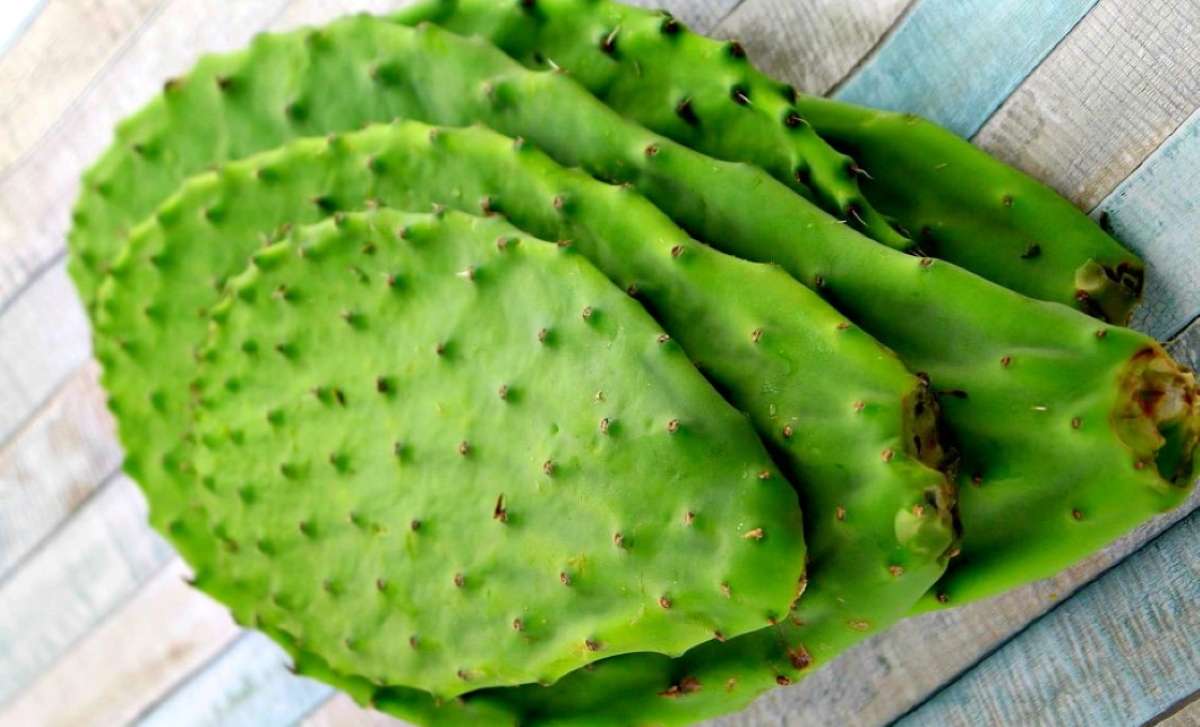
Nopales cactus - used in salads
A typical dessert during lent is Capirotada. This a bread pudding made with toasted French bread, milk, cheese, butter, peanuts, and raisins. This is then covered with a cinnamon syrup or brown sugar.
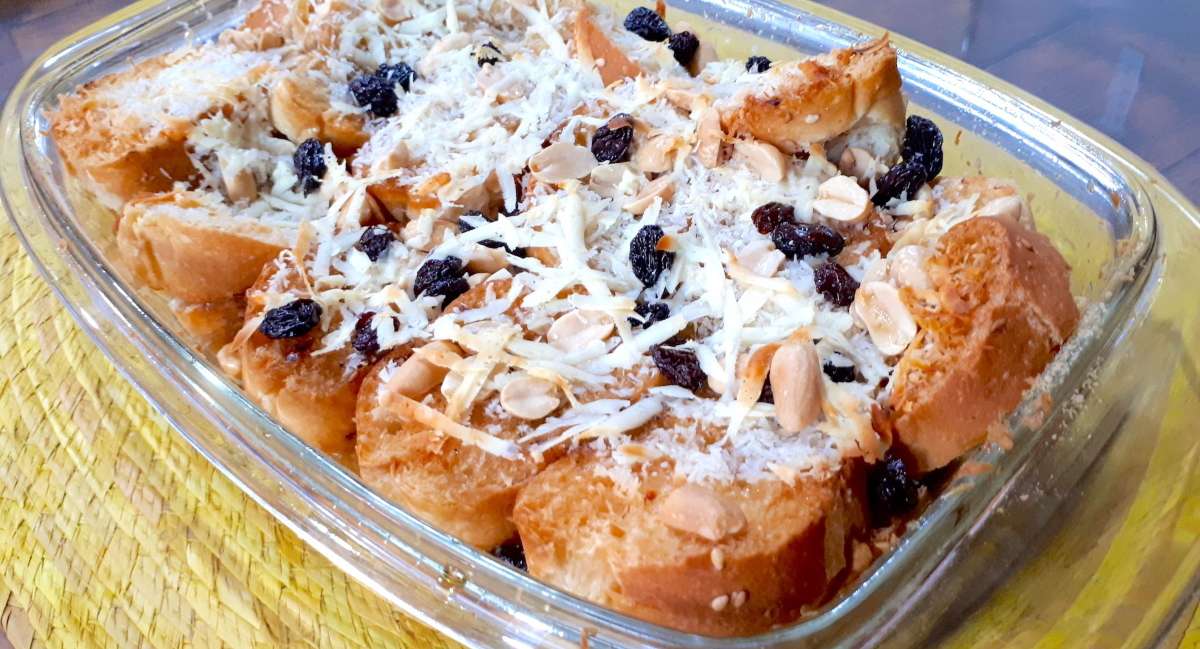
Capirotada - a typical dessert during Lent
Day of the Dead
The Day of the Dead is a holiday celebrated throughout Mexico over 2 days in early November. A celebration of life and death where Mexicans show love and respect for deceased family members. It is an explosion of colour as Mexicans don make-up and costumes, hold parades and parties.
The centrepiece of the celebration are alters created in homes and cemeteries. The intent being to welcome spirits back to the living. As well as flowers the altars are decorated with food – often the favourite dishes of those who have passed. Also, this is often accompanied by Pan de Muerto or Bread of the Dead. It is a sweet bread with anise seeds and decorated with bones and skulls made from dough.

Pozole - one of the 7 Classic Traditional Mexican Recipes you can download
Other dishes often eaten are Mole Negro served with rice, tortilla soup, and chalupas a taco topped with meat, cheese and vegetables. Tamales, and Pozole are both favourites too. A common dessert is a caramel flan topped with brown sugar.
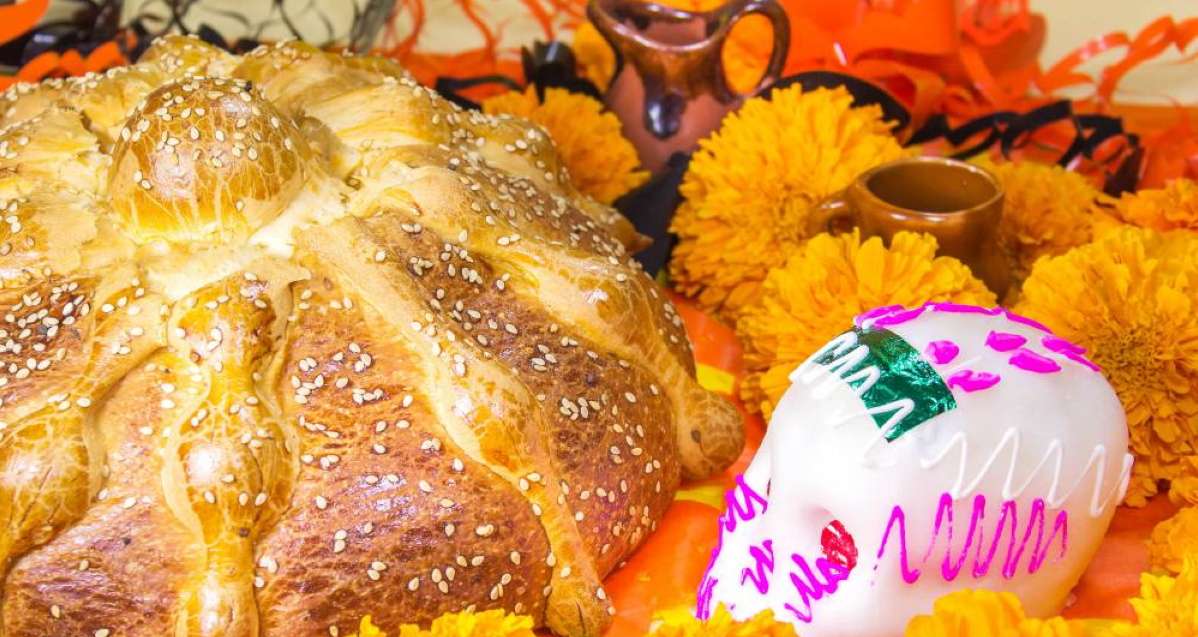
Pan de Muerta
Independence Day
Mexicans across the world celebrate Independence Day on September 16th. In 1810, a priest named Miguel Hidalgo in the Mexican town of Dolores issued the “El Grito de Dolores”. Or “cry for Independence”. During Hidalgo’s famous “El Grito” speech, he motivated the Mexican people to revolt against the tyranny of Spanish rule. He then led a poorly trained army to win several battles and after a decade of fighting, Mexico finally won their independence from Spain in 1821.
The Mexican food aspect of the celebration forms an important part of the day. Part of the parades, parties and other celebrations include food feasts and festivals. Authentic Mexican food includes finger-food, such as Antojitos, a baked tortilla package filled with cheese and peppers. The traditional Ponche drink is also common. Tamales are also eaten - ok so you’ve finally realized tamales get eaten anytime! Queso Fundido (a Mexican cheese fondue), Birria with spice roasted lamb, and Pozole and common as well. One dish that is typical on Independence day is Chiles en Nogada a dish that represents the colours of the Mexican flag. Made of Poblano chiles stuffed with a mix of ground beef, tomatoes, raisins and olives. This is all topped with a walnut based cream sauce (Nogada) and pomegranate seeds.
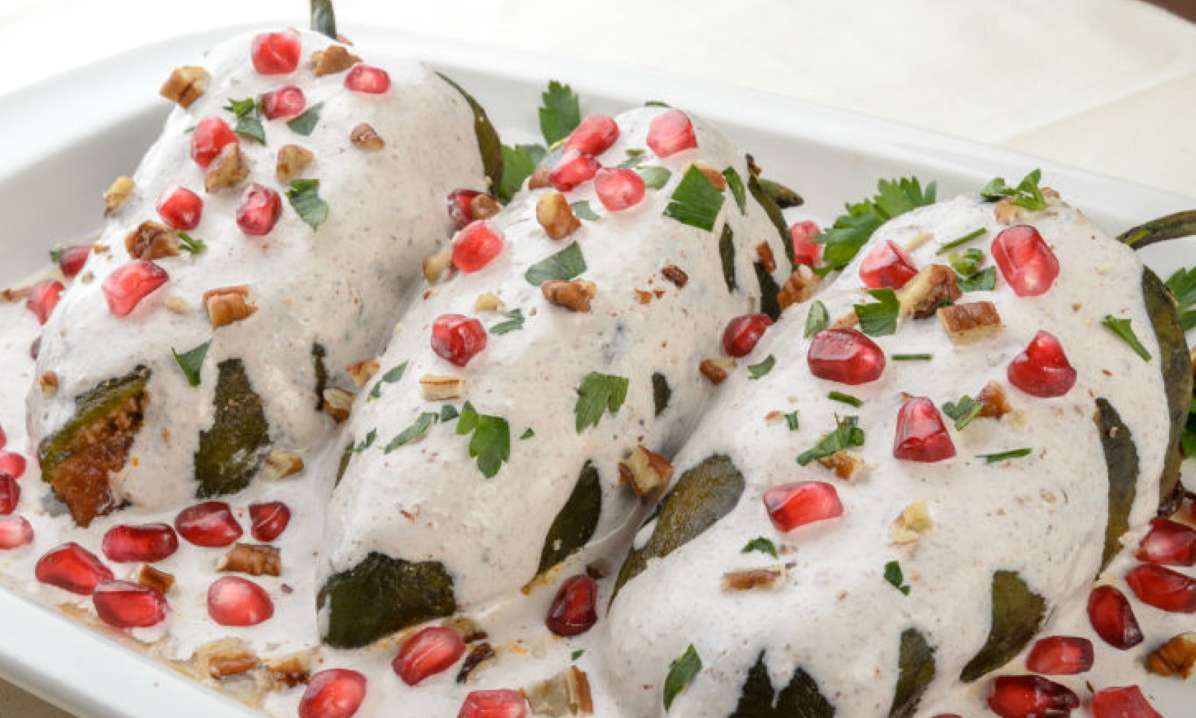
Chiles en Nogada - an Independence Day favourite
Cinco De Mayo
Cinco de Mayo is no longer a national holiday for everyone in Mexico, although schools are closed on May 5th. It celebrates the Battle of Puebla where the Mexican army defeated the French in 1862. While it is a large celebration in the United States it is more muted in Mexico itself. And much less important than Independence Day for Mexicans.
Although more of a US celebration, most traditional Mexican food and Tex-Mex can be prepared to enjoy the celebrations. For example, guacamole, pico de gallo (classic Mexican table salsa), salsa verde, quesadillas, tacos of any description, and of course,…. Tamales!
Weddings
Traditionally an entire town would assist in preparing food for a wedding reception. And of course, everyone would attend! Often a goat or pig would be prepared for the feast along with many traditional side dishes. While the celebrations are often smaller nowadays there are still lots of classic Mexican food involved. This includes a special wedding mole – Mole Blanco.
As well as the special mole, traditional dishes including Birria, braised Pork Carnitas, Pozole, Tamales, Chili Rellenos, and others are served. All before the wedding cake. Traditional wedding cakes consisted of three-layers each infused with milk. Making them soft and delicious. Nowadays cakes have taken on many more varieties. However, in addition to the cake, there is often a dessert table consisting of candies and other treats. This includes the traditional Mexican wedding cookies, Polvorones. These crumbly desserts are made with pecans, butter, and dusted with confectioners sugar.

Polvorones
Birthdays
Birthdays in Mexico are synonymous with pinatas, and mariachi singing. And the traditional Mexican birthday song, “Las Mananitas”. Yet, the most typical Mexican food associated event on birthdays is La Mordida. La Mordida is when the hands of the person celebrating their birthday are tied behind their back. And then their face is pushed into the cake for the first bite! All while everyone around them shouts “Mordida, Mordida, Mordida”. While Mordida can translate into meaning bribe, here it means “taking a bite”. The traditional birthday cake consists of three layers (tres leches) and is very creamy.
Tom Hanks participating in the traditional Mexican birthday celebration.

"Morida, Morida, Morida"
7 Classic Mexican Food Recipes
To help you experience some great and authentic Mexican food we’ve created a concise recipe book with 7 great Mexican food dishes. There is one recipe for each of the 7 food regions within Mexico. Some of the recipes are very straight forward, and a couple, for the amateur chefs among us, are a little more involved. But, all 7 will result in a fabulous Mexican meal.
The recipes are:
- Northern Mexico – Aarachera Fajitas
- Western Mexico – Pozole
- Mexico City – Tacos al Pastor
- Veracruz – Huachinango a la Veracruzana
- Oaxaca – Mole Negro
- Chiapas – Vegan Tamales
- Yucatan – Easy Cochinita Pibil
How to Experience Mexican Food While on Holiday
While you are on holiday it can be harder to experience authentic Mexican food than you thought. For example, if you are staying in an all-inclusive resort there will be a lot of international food served besides Mexican food. Even if you discern the Mexican food, finding traditional Mexican food can be more challenging. Even if you leave the resort on an organized excursion some of the food served is likely to be Tex-Mex. One of the best ways to find good Mexican food is to ask around. But beware of who you ask. You are more likely to get a good recommendation for Mexican food from a resident rather than another tourist!
Obviously, with a bit of research, you can find good local Mexican restaurants. Look for the ones that serve some of the dishes mentioned above – that’ll show you that it might be more traditional food. Also, try to head away from the tourist areas. Instead, go to one of the local pueblos. Most of Mexico, except for a few discrete parts is very safe.
If you are lucky enough to stay at a vacation rental apartment then you have much more flexibility. First, you likely closer to some of the local Mexican restaurants serving old-style favourites. But you also have a kitchen and can try cooking a few yourself. When booking a vacation rental make sure that it has a well-equipped kitchen. And comes stocked with some basic pantry supplies. If you do and try one of the 7 Classic Traditional Mexican Recipes let us know how it was.
As well, you are likely near to some local grocery stores. This is important since it will allow you to buy and try some of the ingredients that aren’t available back home. You can have a food adventure of your own. Either you can go to local pueblo stores and markets, or you can find what you are looking for at some of the larger grocery stores, such as Chedraui. They will have all the supplies you’ll need. Also, there are grocery delivery services that deliver groceries to your apartment.
Tom Hanks gets his Mexican food by cooking in his vacation rental.

And by meeting fans at local Mexican restaurants - as he did here at Bonita Bonita recently
One other way to experience classic Mexican food is to hire a private chef to prepare a fabulous traditional meal. This can make for a great experience as you have the chef come to your vacation rental with ingredients in hand to prepare a Mexican meal of a lifetime. Ask your vacation rental provider for recommendations.
How to Experience Mexican Food While at Home
Perhaps you are at home and looking to try some of these long-established Mexican food recipes. Since Mexican food is often a family affair try getting your partner and/or kids involved as well. Or invite friends around and ask them to bring one of the recipes to try while you make others. If your partner isn’t interested in helping out in the kitchen then give them the task of finding some good tequila, or Mexican beer to go with the food. Or some Mexican wine. Believe it or not, there are some good Mexican wines out there too. But that’s for another blog post!
One of the challenges you may have is finding a few of the ingredients used in some of the traditional recipes. However, there are substitutes that you can use. For example, in our Easy Cochinita Pibil recipe it asks for Achiote paste. That can be hard to find outside of Mexico. Fortunately, we included in the recipe a way to make an Achiote paste substitute with common ingredients that’ll make it taste almost as good.
In Summary - Traditional Mexican Food: Everything you and Tom Hanks ever wanted to know but were too afraid to ask
As you know Mexican food is fun, interesting, healthy, and enjoyable. Now you know how it evolved, what’s traditional Mexican food, and what’s Tex-Mex. And you have 7 great recipes to try at home, or when you’re on your next Mexican vacation. Let us know how much you like them by emailing us, or liking and sharing them below.
About Our Blog
Exploring The Riviera Maya is Ocean Breeze Akumal's Blog. Here we explore the diversity of Mexico's best tourism destination to highlight the best beaches, cenotes, restaurants, attractions, Mayan ruins, etc., etc. We provide information to help you explore this spectacular part of the world and give you tips and tricks that only the locals know. Helping to give you the vacation experience of a lifetime.
If you would like to get a notification each time we post a new article enter your email address in the subscribe box at the bottom of this page and we'll make sure you don't miss a post. If you have requests for future blog posts email us at info@oceanbreezeakumal.com. We'd also really appreciate it, if you find one of our posts to be interesting and informative, if you'd like and share it to your social networks.
Contact Us
For information about accommodation, vacation options, or questions about the Riviera Maya, contact us.
Email info@oceanbreezeakumal.com
WhatsApp + 1 250 538 8159 or + 52 984 168 7244
Phone + 1 250 538 8159


